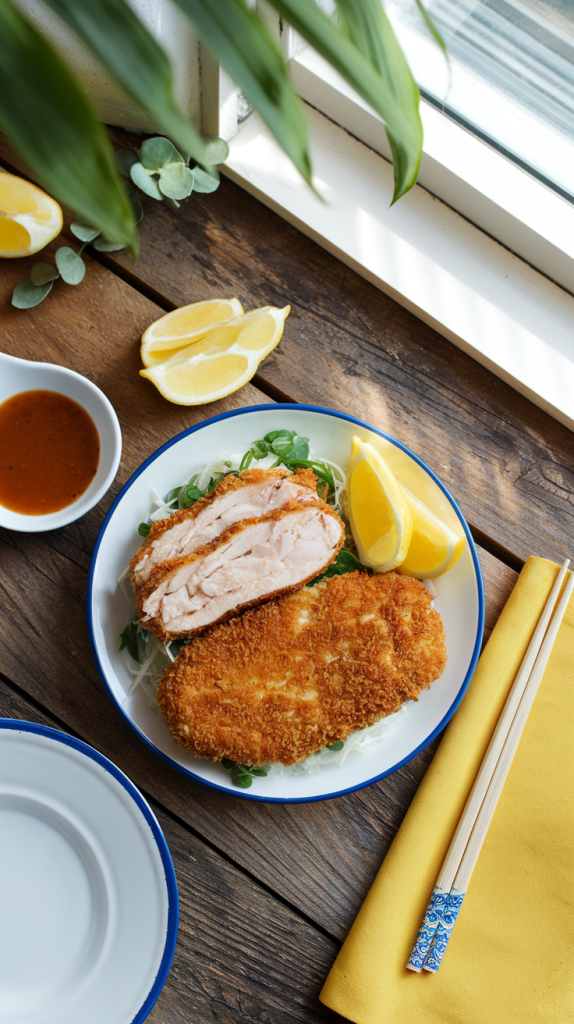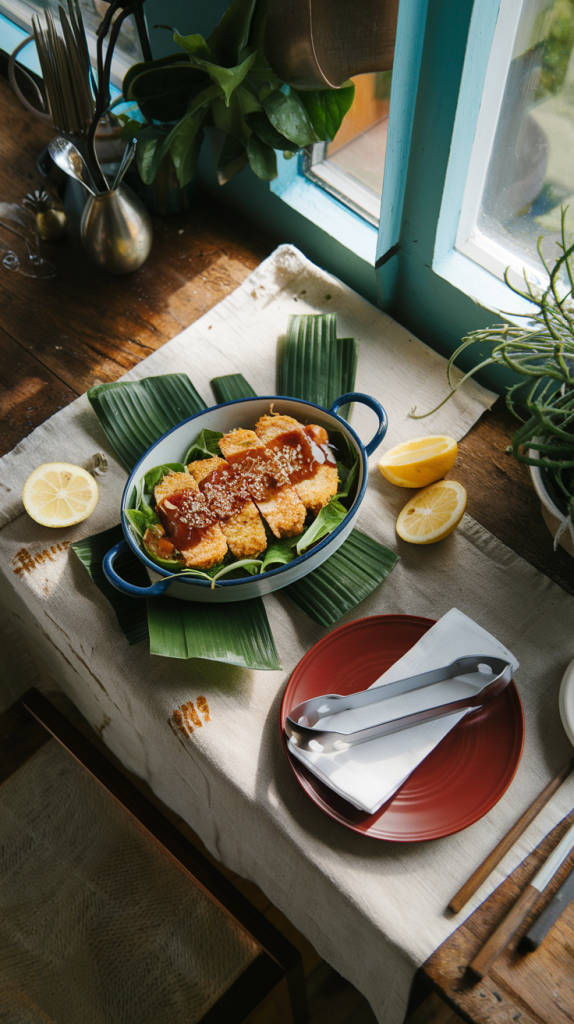Chicken Katsu is Japan’s beloved take on a breaded, deep-fried chicken cutlet—crispy on the outside, tender and juicy on the inside. Served with a rich, tangy tonkatsu sauce and crisp cabbage, it’s a perfect blend of texture and flavor. In this guide, we provide a foolproof method to achieve golden-brown perfection, whether you’re making a weeknight dinner or a Japanese-style bento lunch.

Ingredients – Authentic and High-Quality
Chicken Katsu Cutlets
- 2 boneless, skinless chicken breasts (or 4 thighs)
- ½ teaspoon sea salt
- ¼ teaspoon freshly ground black pepper
- ½ cup all-purpose flour
- 2 large eggs, lightly beaten
- 1 ½ cups Japanese panko breadcrumbs
- Neutral oil for deep-frying (vegetable, canola, or peanut oil)
Homemade Tonkatsu Sauce
- 3 tablespoons ketchup
- 2 tablespoons Worcestershire sauce
- 1 tablespoon soy sauce
- 1 tablespoon mirin or rice vinegar
- 1 teaspoon Dijon mustard
- ½ teaspoon brown sugar
Garnishes and Accompaniments
- Finely shredded green cabbage
- Lemon wedges
- Steamed short-grain Japanese rice
- Japanese pickles (fukujinzuke or takuan)
Preparing the Chicken Katsu Step-by-Step

1. Prepare and Flatten the Chicken
- Trim fat from chicken breasts and slice each in half lengthwise to create two thinner cutlets.
- Place the cutlets between plastic wrap and pound with a meat mallet until uniformly ½ inch thick.
- Season both sides with sea salt and freshly ground pepper.
2. Set Up a Breading Station
- Place flour, beaten eggs, and panko in three separate shallow dishes.
- Dredge each cutlet first in flour (shake off excess), then dip into egg, and finally press into panko until fully coated.
3. Fry to Crisp Perfection
- Heat 1½ to 2 inches of oil in a deep skillet or pot to 340–350°F (170–175°C).
- Fry each cutlet for 3–4 minutes per side or until golden brown and internal temperature reaches 165°F (74°C).
- Transfer to a wire rack (not paper towels) to maintain crunch.
4. Prepare the Tonkatsu Sauce
- In a small bowl, whisk together ketchup, Worcestershire, soy sauce, mirin, mustard, and sugar.
- Adjust seasoning to taste—add more vinegar for tang, sugar for sweetness, or mustard for depth.
How to Serve Chicken Katsu the Traditional Way
- Slice chicken diagonally into strips.
- Plate beside a generous mound of finely shredded cabbage.
- Drizzle with tonkatsu sauce or serve on the side for dipping.
- Add steamed Japanese rice and miso soup for a complete teishoku-style meal.
Creative Variations of Chicken Katsu
Chicken Katsu Curry
- Serve sliced katsu over a bed of rice smothered in Japanese curry sauce made with carrots, potatoes, and onions.
Katsu Sando (Katsu Sandwich)
- Sandwich crispy chicken between soft shokupan (milk bread) with shredded cabbage and sauce.
Baked or Air-Fried Katsu
- Bake at 400°F (200°C) for 20 minutes, flipping once, or air-fry at 375°F (190°C) for 12–14 minutes. Spray lightly with oil for best results.
Spicy Katsu
- Add chili oil or togarashi (Japanese pepper blend) to your tonkatsu sauce or sprinkle on top before serving.
Bento Box Chicken Katsu
- Chill and slice chicken cutlets into bite-sized strips.
- Pack with rice, tamagoyaki (Japanese omelet), steamed broccoli, and a container of tonkatsu sauce for dipping.
- Add pickled ginger or umeboshi (pickled plum) for a traditional touch.
Storage and Reheating Tips
- Refrigeration: Store leftovers in an airtight container for up to 3 days.
- Freezing: Flash-freeze cutlets on a tray, then transfer to freezer bags for up to 2 months.
- Reheating: Use an oven or air fryer to restore crispness—avoid the microwave.
Nutrition Facts (Per Serving Approximation)
- Calories: 510 kcal
- Protein: 36g
- Fat: 28g
- Carbohydrates: 30g
- Sodium: 720mg
- Fiber: 2g
Chicken Katsu Workflow Diagram (Mermaid Syntax)
Frequently Asked Questions
What makes panko different from regular breadcrumbs?
Panko is made from crustless bread baked with an electric current, resulting in large, airy flakes that fry up extra crispy and light.
Can I use pork instead of chicken?
Yes. This would turn the dish into Tonkatsu, the original pork cutlet version. Follow the same method using pork loin or tenderloin.
Can I make Chicken Katsu gluten-free?
Yes. Use gluten-free panko and substitute rice flour for wheat flour. Ensure all sauces used are gluten-free.
Why is my katsu not crispy?
Possible reasons include oil temperature being too low, using regular breadcrumbs instead of panko, or overcrowding the pan. Always fry at 340–350°F in small batches.
What oil is best for frying Chicken Katsu?
Use a neutral oil with a high smoke point like canola, vegetable, sunflower, or peanut oil. Avoid olive oil or butter for deep frying.
Conclusion
Our Chicken Katsu recipe is a definitive guide for achieving golden, crispy perfection with authentic Japanese flavor. Whether served in a curry bowl, sando, or a classic teishoku plate, this dish combines technique, texture, and taste into one unforgettable experience. Master it once, and it will become a staple in your kitchen.